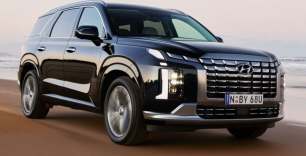This is an easy driving wagon. It's nice and comfortable, it's refined, it's always composed and it's always controlled and it's just an all around nice drive from the engine and the auto, which are a really good pairing.
As mentioned earlier, kerb weight is listed as 2070kg and this Palisade has an 11.8m turning circle, so it’s not an insubstantial vehicle to steer around.
It’s not very dynamic, not very lively, but it has a nice consistent feel to it all – and being composed and consistent is important with something that's intended as a people mover, as a family vehicle because that's what you want.
Ride and handling are well sorted out and, though there’s a touch of firmness to the suspension, ride quality is smooth in general terms.
There are the paddle shifters on the steering wheel if you want a little bit more input into shifting up and down in the automatic transmission, but it’s rather clever so you can just let it do its job as it does that nicely.
There are four on-road drive modes – Comfort, Eco, Sport and Smart. Smart tweaks vehicle characteristics such as engine output, transmission settings and braking to suit your driving style, and depending on which of the other modes you select, it will adjust those characteristics and/or more to suit the terrain or the conditions you’re driving in.
And while this Palisade is impressive in terms of performance and driving characteristics, there are a few niggles.
Acceleration is a bit laggy and it takes a heavy right boot to get the Palisade moving at pace.
Some of the driver-assist tech is often abrupt and intrusive. The traffic-sign recognition (or speed limit assist) is clunky. It detects and reacts to signs that don't apply at that time of day, say school zone signs, or it picks up on signs that don't apply to that section of road.
So, it's forever chopping and changing between speeds you should be at and speeds you shouldn't. You can adjust those settings or switch them off in the Hyundai app via the touchscreen multimedia system, but those settings return as defaults when you next start the vehicle.
Now for some dirty talk. The Palisade Calligraphy is an all-wheel drive SUV wagon that does sufficiently well on terrain that would be moderately challenging for a 2WD vehicle.
Our light-duty test track is sandy and there are some very shallow wheel ruts – nothing serious – and this Palisade handled all of the minor challenges well.
Ride quality over some of the lumpier sections was good. It's a bit on the firm side as you'd expect because this is a SUV designed for the suburbs not the Simpson, but it is perfectly reasonable on a very easy dirt track in dry conditions.
And that’s the good thing about an AWD over a 2WD vehicle; you have that extra degree of traction, especially if you get into a traction-compromised situation such as a slippery wet bitumen road or a slightly muddy, but otherwise well-maintained, gravel route.
This Palisade has three terrain driving modes – Sand, Mud, and Snow – which each adjust throttle response, engine output, and the automatic transmission, among other things, to ensure you keep moving safely with controlled momentum.
If you’re planning to use your daily driver / family mover as a towing platform it’s handy to note that the Pailsade’s towing capacity is 750kg (unbraked) and 2200kg (braked).

